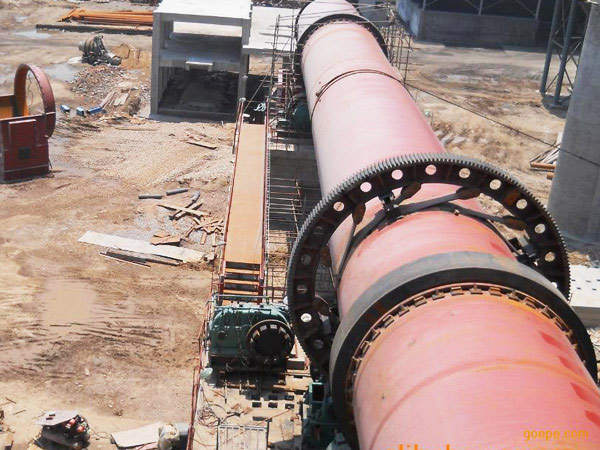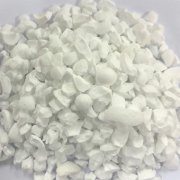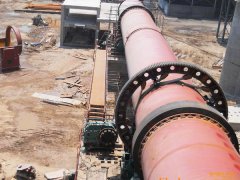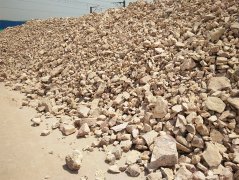Method for calcining bauxite high alumina
Jan 08, 2022
Method for calcining bauxite high alumina
The traditional method of calcining bauxite is as follows: raw material entering the factory→storage→crushing→grinding→pressure filtration→liming→extrusion molding→drying→calcining→crushing→factory product due to the instability of bauxite raw material composition. , the quality of the bauxite clinker obtained by this traditional calcined bauxite clinker production process is not high, and the product quality is unstable, in order to obtain high-quality bauxite clinker, the proposed new calcined bauxite clinker The method of soil is as follows: incoming raw materials → warehouse → crushing → grinding → desiliconization → wet homogenization → pressure filtration → mud refining → extrusion molding → drying → calcination → crushing → finished product.

In the process of producing bauxite clinker, the calcination of bauxite has a great influence on the clinker taste, so it is very important to choose a calcining kiln for bauxite. The methods of calcining bauxite mainly include the method of calcining bauxite in down-flame kiln, the method of calcining bauxite in rotary kiln, the method of calcining bauxite in tunnel kiln, the method of calcining bauxite in shuttle kiln, etc.
(1) The method of calcining bauxite in a down-flame kiln is a batch kiln. Its name is derived from the flow of flames. The flames generated by the combustion all ascend from the nozzle of the combustion chamber to the top of the kiln. Since the top of the kiln is sealed, the flame cannot continue to ascend. In the absence of an air outlet on the top of the kiln, it is pulled down by the chimney's pulling force and passes through the kiln. The gap between the saggar columns enters the branch flue from the fire suction hole at the bottom of the kiln, and the main flue is discharged from the chimney. Because the hot gas is light in weight and always floats on the top, people are used to calling the flame "shun" from bottom to top. And the flame flowing from top to bottom is called "downward", which is the origin of the name "downward flame kiln"!
The advantages of the method of calcining bauxite in the inverted flame kiln are that the volume of the kiln can be large or small, the production flexibility can be obtained, the products of good quality can be obtained, the construction cost is low, and the consumption of metal materials is low. The disadvantages are intermittent operation, high temperature of waste gas leaving the kiln, so the fuel consumption per unit product is large; the production scale is small; the labor conditions are poor; the level of mechanization is low; the operation control is difficult; the production efficiency is low; the environmental performance is poor. Generally, the thermal efficiency of the inverted flame kiln is only 6.48%, and the coal consumption per ton of fired products is as high as 1.456 tons.
(2) The method of calcining bauxite in rotary kiln refers to rotary calcining kiln, which originated from cement production. Now, in many production industries such as building materials, metallurgy, chemical industry, environmental protection, etc., rotary kiln equipment is also widely used for mechanical, physical or chemical treatment of solid materials. Most of the rotary kilns for calcining bauxite are changed from heavy oil as fuel to pulverized coal.
The characteristics of the method of calcining bauxite in rotary kiln are: simple structure, few wearing parts, easy control of production process and high operation rate; easy to large-scale production; and easy to realize automatic control and stable product quality.
(3)的方法在隧道窑煅烧铝土矿is a modern continuous calcining thermal equipment, which is widely used in the roasting production of ceramic products, and is also used in metallurgical industries such as abrasives. Tunnel kilns are mainly used for firing products. The refractory industry can be divided into three types according to different operating temperatures. Low-temperature tunnel kilns are mainly used for roasting slide bricks, etc., with a firing temperature of about 1000 °C; medium-temperature tunnel kilns are mainly used for firing Ordinary alkaline bricks, clay bricks, high alumina bricks, silica bricks, etc., the firing temperature is 1300 ℃ ~ 1650 ℃; high temperature tunnel kiln is mainly used for firing mid-grade magnesia bricks, high purity magnesia bricks, magnesia alumina and corundum products. The forming temperature is greater than 1700 °C, generally between 1800 °C and 1900 °C. High labor intensity, low production efficiency, high heat consumption, difficult to achieve automatic control.
Reminder: The main factors affecting the method of bauxite calcining bauxite are secondary mullite formation, liquid phase and the structure of bauxite. Secondary mullite formation is the inevitable occurrence of DK type bauxite during the calcination process The reaction often causes a volume expansion of about 10%, which hinders sintering. The reason is that the volume of the material itself increases due to the change of specific gravity when secondary mullite is formed; The sub-mullite reacts and pushes away from each other, thereby forming voids between the particles. In addition, the first mullite film formed around the particles during the reaction also hinders the further diffusion of aluminum and silicon ions, making the reaction difficult to complete.
The heating change of the method of calcining bauxite during bauxite calcination can be divided into 3 stages decomposition stage (including thermal decomposition reaction of kaolinite and decomposition of diaspore), secondary mulliteization stage and recrystallization sintering stage .
的分解阶段the method for calcining bauxite. The temperature range of 400~1200℃ is the decomposition stage of bauxite. At this stage, the diaspore and kaolinite in bauxite begin to dehydrate at 400°C, and react violently at 450-600°C, and complete at 700-800°C. After the diaspore is dehydrated, a false phase of corundum is formed. This false phase still maintains the shape of the original diaspore, but the edge is blurred, and the refractive index is lower than that of diaspore, and it gradually transforms into corundum at high temperature. Metakaolinite is formed after dehydration of kaolinite. When the temperature is higher than 950 °C, metakaolinite is transformed into mullite and amorphous SiO2, and the latter is transformed into cristobalite at high temperature, and the volume shrinks by 20% in the whole process.
Method for calcining bauxite secondary mulliteization stage. At 1200-1400 ℃, the a-Al2O3 generated by the decomposition of diaspore can continue to react with the free SiO2 precipitated during the conversion of kaolinite to mullite to form mullite. With the formation of secondary mullite, a large volume expansion occurs, reaching about 10%, which makes the fired products loose, the porosity increases, and the size is difficult to control, which is also the reason why bauxite is difficult to sinter.
The method of calcining bauxite recrystallizes the sintering stage. Occurs in the temperature range of 1400 to 1500 °C. During the secondary mulliteization stage, sintering has begun to occur due to the formation of the liquid phase, but the process is slow. When the secondary mulliteization is completed, recrystallization and sintering begins to proceed rapidly. At 1400-1500 ℃ and above, due to the action of the liquid phase, the porosity decreases, the material rapidly tends to be dense, and the corundum and mullite crystals grow.
高铝熟料ob的主要矿物相tained by calcining high alumina bauxite are a-Al2O3 phase, mullite and glass phase, and their content has a certain relationship with the ratio of Al2O3/SiO2 in the raw material. There may also be aluminum titanate phase (SiO2·TiO2) in super alumina and first grade alumina.
Compared with the traditional calcining method, the method of calcining bauxite has the following characteristics: 1. Low energy consumption, 40% lower coal consumption per unit than ordinary spherical top converter, high product quality, good stability, and strong market price advantage . 2. The operation is simple, reliable, with few personnel and stable process. 3. Small environmental pollution, low maintenance and high operation rate. 4. It can be applied to various fuels such as coal gas, pulverized coal and fuel oil. 5. It can be upgraded to automatic control, and the system is more stable.
Relevant information
-

Study on the production Technology and Properties of White Sintered Tabular Alumina
The production Technology and Properties of White Sintered Tabular Alumina Sintered tabular corundum is produced by rapid ultra-high temperature sintering without any additives and over 1800 ℃. Its m ... -

Method for calcining bauxite high alumina
Method for calcining bauxite high alumina The traditional method of calcining bauxite is as follows: raw material entering the factorystoragecrushinggrindingpressure filtrationlimingextrusion moldingdr ... -

Clay fire bricks products
Clay firebricks refer to fireclay bricks with an alumina content of 48%-33%. The product is cheap and widely used such as fire clay brick for steel industry . t3 refers to the size model of standard br ... -

High alumina bauxite refractory raw material
High alumina bauxite of high alumina refractory raw material Aluminum refractory raw materials refer to AL₂O₃-SiO₂ refractory raw materials with AL₂O₃ content greater than 48%, which mainly i ...





